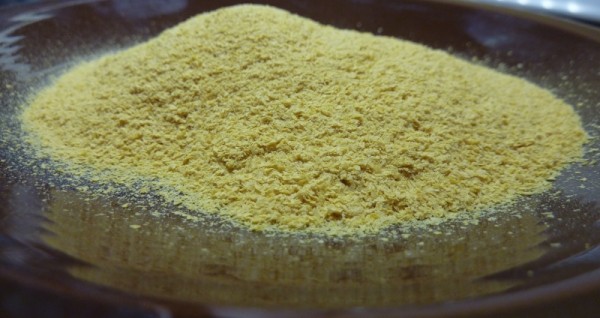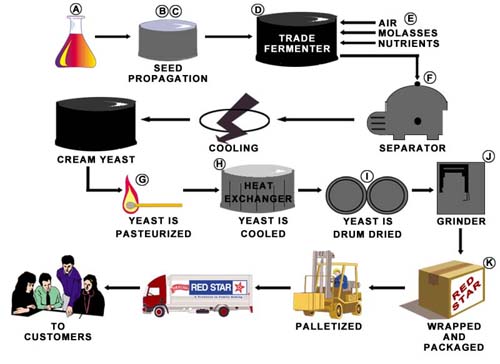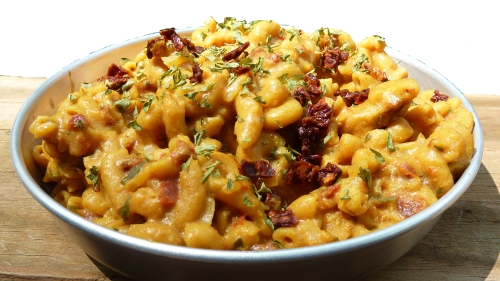
We often are asked why we use nutritional yeast in some of our vegan products. Nutritional yeast is prized for its creamy, cheese-like flavor and concentrated source of protein and B-complex vitamins. It is an excellent cheese replacement for backpacking because it requires no refrigeration and has a long shelf life. It makes a versatile condiment for various dishes, such as pasta, or a topping to sprinkle on snack foods, such as popcorn. It also contains very low sodium.
Nutritional yeast is a deactivated form of Saccharomyces Cerevisiae. Nutritional yeast has no fermenting or leavening power, unlike live yeast used in bread making and brewing. Since nutritional yeast does not contain active yeast, it is acceptable for those following a diet designed to manage Candida albicans. Brewer’s and nutritional yeast are from the same fungus, which is deactivated by pasteurization and drying. Both yeasts are ready to eat straight from the package.
Brewers Yeast versus Nutritional Yeast
While brewer’s yeast and nutritional yeast provide similar nutrition, there is a significant difference between them. Brewer’s yeast is a by-product of the beer brewing industry and has a bitter hops flavor.
Nutritional yeast has a pleasant, cheese-like flavor and is purposely grown on molasses or sugar cane to create a food or dietary supplement. Fortified nutritional yeast can also serve as a dietary supplement due to the high levels of B vitamins, including B12, an essential nutrient for vegans who are often deficient without supplementation. Conversely, brewer’s yeast does not contain a significant amount of vitamins. However, it can provide a good source of chromium, which is essential for the diabetic or hypoglycemic diet.
Additionally, because nutritional yeast does not come in contact with barley (like brewer’s yeast), it is gluten-free.
How Nutritional Yeast is made
After the nutritional yeast has fermented, the culture is pasteurized and drum dried to destroy the live yeast. You never want to consume live active yeast (i.e., baking yeast) as a food supplement because the live yeast will continue to grow in the intestine and deplete the body of nutrients. However, once the yeast is inactivated through pasteurization, it provides excellent nutrition. Hence, nutritional yeast is sold as a supplement and food source in the form of powders, flakes, and spreads – such as Vegemite, a sandwich commonly used in the UK and Australia. Nutritional yeast also referred to as “nooch,” “vegetarian yeast,” “savory yeast,” or “hippie dust,” adds flavor and nutrition to dishes.

What to look for when purchasing nutritional yeast
- Fortified with B12, a vitamin lacking in most vegetarian/vegan diets. Not all brands of nutritional yeast have B12 added.
- Pasteurized at low temperatures. Nutritional yeast processed at high temperatures forms elevated concentrations of free glutamic acid, an amino acid protein naturally present in yeast and a natural form of MSG.
- A dark yellow color, indicating it contains a high amount of riboflavin (vitamin B2).
- Dissolves easily.
Nutritional yeast as a food
Keep in mind that both nutritional yeast/brewers yeast are considered a health food because they are very concentrated in nutrients. Therefore, you do not need to consume much (1-2 TB is a sensible serving). Nutritional yeast contains all nine essential amino acids that you must obtain from food making it a complete source of plant protein.
Nutritional yeast is available in powder or flake form at most natural food stores across the U.S. The flakes are used as a condiment to sprinkle on pizza or pasta (as you would Parmesan cheese), and the powder works well for popcorn, gravy, sauces, and casseroles.
Use nutritional yeast much like you might add cheese to dishes:
- Sprinkle on popcorn instead of butter and salt.
- Add in pasta and casseroles to give a cheesy flavor.
- Add to soups, gravies, or sauces to add a creamy taste without using milk.
- Use it with baked or mashed potatoes.
- Add to scrambled tofu/eggs instead of cheese.
- Add to smoothies to boost nutrition.
Is nutritional yeast high in sodium? Is it gluten-free or GMO-free?
Outdoor Herbivore incorporates Red Star vegetarian nutritional yeast in all of our meals that include this ingredient. This yeast has a very low sodium content—only 5 mg per 1.5 tablespoon serving—allowing you to enjoy a robust flavor with low sodium. Furthermore, Red Star Nutritional Yeast is non-GMO and gluten-free, making it safe for individuals with celiac disease.
Ingredients in Red Star Nutritional Yeast:
– Inactive dry yeast
– Niacin (B3)
– Pyridoxine hydrochloride (B6)
– Thiamin hydrochloride (B1)
– Riboflavin (B2)
– Folic acid (B9)
– Cyanocobalamin (B12)
The cyanocobalamin (Vitamin B12) is produced through natural fermentation, ensuring it is non-synthetic and non-animal sourced.
Below is the breakdown of the Daily Value (DV) per 16 gram serving.
| Nutrients | Per 1.5 Tablespoon Serving (16g) |
| Calories | 60 |
| Total Fat | 1 gram |
| Carbohydrate | 7 grams |
| Fiber | 4 grams |
| Protein | 8 grams |
| Sodium | 5 milligrams |
| Vitamin B1 (thiamin) | 640% DV |
| Vitamin B2 (riboflavin) | 560% DV |
| Vitamin B3 (niacin) | 280% DV |
| Vitamin B6 | 480% DV |
| Folic Acid | 60% DV |
| Vitamin B12 | 130% DV |
| Selenium | 30% DV |
| Zinc | 20% DV |
The backpacking meals that Outdoor Herbivore makes with nutritional yeast include:
- Basil Walnut Penne
- ‘Cheddar’ Mac
- Happy Fella PestoBella
- Pesto Herbilicious
- Spicy Vegan Squeezy
- Sunrise Tofu Scramble
We stand by our philosophy that it is better to consume fresh foods naturally present in nature instead of synthetically processed foods. However, there are no plant foods that reliably contain B-12, and nutritional yeast is an economical way for vegans to get this vital nutrient and recreate a cheesy flavor.

In Summary
Nutritional yeast is rich in essential nutrients. It is a complete protein source, containing all nine essential amino acids. It’s also packed with vitamins, particularly B vitamins, including B12 (when fortified). Nutritional yeast can be used to create non-dairy cheese substitutes, adding creaminess and depth to meals. It is no surprise that nutritional yeast is such a remarkable and valuable food, especially for vegans.
3 thoughts on “Nutritional Yeast is More than a Vegan Cheese: It’s A Powerhouse of Nutrients”
What brand of nutritional yeast has no folic acid added?
I also want to know which brand, if any, has no folic acid. I saw that Bob’s Red Mill listed Folate in the nutritional info, but in the ingredients it listed Folic Acid. Pretty sneaky there. I couldn’t find any folic acid free products that were also enriched with B12.
Sari Foods makes a non-fortified Nutritional Yeast without folic acid, the synthetic form of vitamin B9. It also does not contain B-12. http://amzn.to/1TBrfct